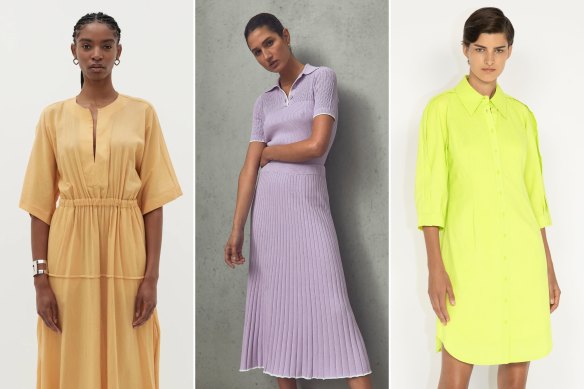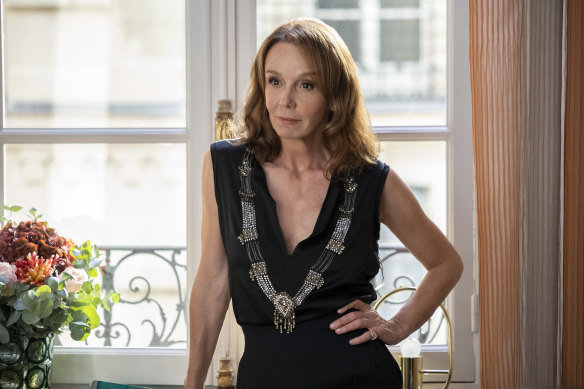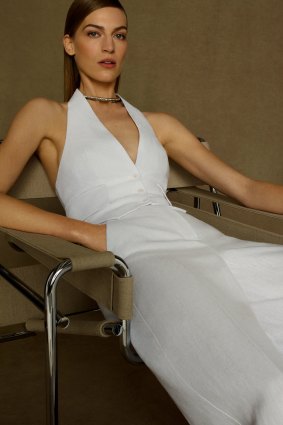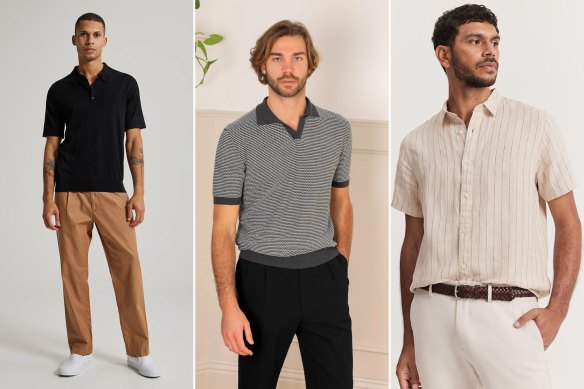Consider what people think of as office dress standards during January, and you’ll likely observe some interesting interpretations. There are the people in suits who are happy sweating if it means they don’t need to attempt “smart casual” each morning, to those who think that working through summer is a licence to wear shorts and thongs to the office. Neither are entirely correct nor incorrect.
After a couple of summers spent in bike shorts and a singlet thanks to COVID-19 working-from-home directives, office life in January is once again a thing. And, it seems, some of us could use a reminder about the basic rules of “January casual”.

Summer office days call for sunset colours. From left: Bassike, Viktoria & Woods (arrives February), Cue.
Dressing for the office in January is fraught because there are so many factors: an unwritten rule of “no suits before Australia Day” in some offices; the heat; the yearning to still be on holidays, if not in body, at least in dress; and the airconditioning, which can make some workplaces feel like mid-July even when the mercury is nudging 40C.
So, how does this all translate into a work wardrobe that toes the line between post-holiday glow and a soft re-entry to power dressing for the new year?
Monique Santos, head of brand at Scanlan Theodore, says regardless of workplace, dressing for the heat requires “effortless silhouettes”. Leave bodycon for swimwear and instead choose natural fibres, such as linen, cotton and silk. As Sylvie Grateau’s character in Emily in Paris proves, a silk blouse can prove invaluable when you want to stay cool but don’t want to show too much flesh (because, after all, it’s set in Paris, not Positano).

Emily in Paris’ Sylvie Grateau (Philippine Leroy-Beaulieu) nails summer office style.Credit: Marie Etchegoyen/Netfli
“Invest in timeless silhouettes – polished shirting, beautifully tailored co-ord sets and feminine dresses, which can be accented with accessories for a touch of modern elegance whilst keeping cool,” Santos says, adding that for a colour palette, look to apricots, mauves, pinks and yellows – the colours of sunset.
Another designer leaning into her inner Sylvie is Viktoria & Woods’ Margie Woods. Although the fictional character would probably sooner die than wear a pair of shorts to work, Woods says they are always acceptable when paired with a blazer, belt and loafer.
Speaking of accessories, Woods says they are key to elevating a pair of jeans or other casual outfits to make them more office-appropriate. “Belts, footwear and jewellery are often overlooked in importance but shouldn’t be. They finish and add depth to an outfit and help transform the staples.”
Men can also lean into colour at this time of year through a faded tangerine linen shirt paired with a tapered chino and loafer, or a chevron-patterned knitted polo in light blue and lemon with a dark jean, or, gasp!, a tailored short.

A waistcoat and pants make a cool summer set.Credit: Scanlan Theodore
Which brings us to a debate as old as the fax machine when it comes to summer office dressing: are shorts ever OK? A quick survey of my train this week would suggest no, but few workplaces officially ban them. A spokeswoman for KPMG says employees need to decide based on their workday. For instance, if staff are spending the day in the office, shorts are less of an issue than, say, if they are client-side with people who conventionally wear suits. In short, common sense seems to rule, particularly in January.
Men who choose to wear shorts are encouraged to seek out drill styles with some kind of hardware or dressier buttons, to distinguish them from styles one would wear to the beach. And I’ll repeat some advice a stylist gave me a few years ago: choose one aspect of the outfit to make casual and dress up the rest. So shorts with a shirt, or chinos with a polo or T-shirt, but never shorts and a T-shirt together.
Also, if you’re sitting at a desk for eight hours, linen may not be the best option, as it can look rumpled if it isn’t given opportunity to “fall” throughout the day, says Chloe McCormack, head of womenswear for Oscar Hunt. Instead, go for a linen/wool or linen/silk blend.
She advises clients to invest in three key pieces for summer: a great quality A-line dress in a midi length, an A-line skirt or tailored trouser in a similar fabric and a lightweight wool blazer.

Ditch the dress shirt for another few weeks with lightweight alternatives by (from left) Jac & Jack, Christian Kimber and Country Road.
As for the ideal summer suit, McCormack says it should be “breathable, light weight, and made from natural fibres to ensure comfort. Synthetic fabrics such as polyester may cause you to sweat on warmer days, and tend to insulate your body heat”.
And where does she sit on the shorts debate? “I love a tailored short, so it’s a ‘yes’ from me, but it needs to be styled appropriately for the office. A tailored short that sits just above the knee paired with a blazer and heels [for women] makes for a very chic office look.”
She also loves the current, and very Parisian, look of a matched waistcoat and pants, “but if this is something you’re opting for, keep in mind that it’s best worn as a set, waistcoats can at times be tricky to pair with other items in your wardrobe”.
How to dress for the office in summer
DO: Wear shorts, but only if you can maintain polish with a tailored shirt and closed shoe. If you have to ask “do I look like I’m going to the beach”, then you’ve probably missed the mark.
DO: Wear colour. Acid brights with a faded or vintage look, such as lilac and tangerine, are perfect.
DO: Wear linen. It’s cool - but watch the crush factor.
DO: Cut your toenails, if you want to wear sandals. But leave thongs and Birkenstock styles for the weekend.
DON’T: Be too formal. If you can’t ditch the suit altogether, leave the tie and experiment with wearing a polo or tee instead of a dress shirt.
DON’T: Be too casual. Pick one item or half of your body to dress down and balance it out with a sharper silhouette on the other half.
DON’T: Forget a hat. The commute is prime time to get burnt, so take care.
Make the most of your health, relationships, fitness and nutrition with our Live Well newsletter. Get it in your inbox every Monday.